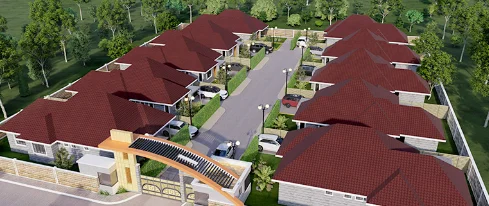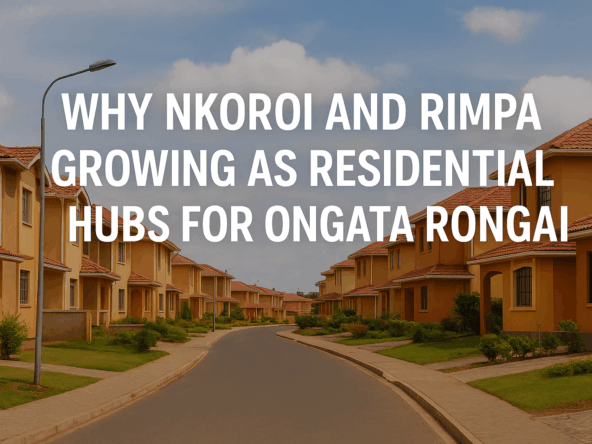In the real estate market in Kenya today, there exist old houses and new ones. Therefore, when buying a home, one of the key decisions you’ll need to make is whether to purchase a newly constructed, developer-built house or an older, pre-owned, owner-built home.
Each option comes with its own set of advantages, challenges, and considerations, depending on factors like budget, personal preferences, lifestyle needs, and long-term plans.
This comprehensive guide will walk you through the pros and cons of buying a new developer-built house versus an old pre-owned house, helping you make an informed decision on which option best suits your needs.
The difference between a Developer-Built House and a Pre-Owned House

What is a Developer-Built House?
A developer-built house refers to a newly constructed home that has been built by a real estate development company.
In Kenya, these houses are often part of new residential developments or communities and come with modern designs, updated features, and the latest construction standards.
What is a Pre-Owned House?
A pre-owned house, often referred to as a resale home, is a property that has been previously built and lived in by the previous owner.
These homes vary greatly in age, with some being only a few years old, while others may be several years or even decades old. Pre-owned homes often have their unique charm and history as they have a history with the past owners.
Pros and Cons of Buying a New Developer-Built House
Advantages of Developer-build Houses
1. Modern Designs and Features
New homes are designed with modern living in mind, featuring open floor plans, energy-efficient systems, and the latest technology.
These homes often come with state-of-the-art appliances, smart home features, and contemporary finishes, making them attractive to buyers who want a home that requires minimal updates or renovations.
2. Energy Efficiency
New developer-built homes are constructed to meet current building codes, often including strict energy efficiency standards.
New homes typically have better insulation, energy-efficient windows, and modern HVAC systems, which can lead to lower utility bills and an eco-friendly lifestyle.
3. Lower Maintenance Costs
One of the biggest advantages of buying a new house is that everything is brand new. From the roof to the plumbing, electrical systems, and appliances, you won’t have to worry about major repairs or replacements for several years.
Most new homes also come with warranties that cover major components, giving you peace of mind and saving you money on maintenance.
4. Customization Options
When purchasing a home in a new development, buyers often have the opportunity to customize certain aspects of the home, such as the flooring, countertops, cabinetry, and paint colors.
Some developers even allow buyers to make more significant design choices, such as altering the floor plan or adding extra rooms, depending on the stage of construction.
5. Community Amenities
Many new housing developments are planned communities with amenities like parks, playgrounds, swimming pools, gyms, and even schools.
These amenities are designed to enhance the quality of life for residents and create a sense of community.
6. Fewer Safety and Health Risks
Because new homes are built to meet the latest safety standards, you’re less likely to encounter issues like asbestos, lead paint, or outdated wiring, which can be present in older homes.
This makes new homes safer for families, particularly those with young children.
Disadvantages of Buying a New Developer-Built House

1. Higher Buying Price
New homes typically come with a higher price tag compared to older homes in the same area.
Developers set their prices based on the cost of new materials, labor, and modern finishes, which can drive up the overall cost of the home.
If you’re on a tight budget, this could limit your options.
2. Limited Character and History
While new homes offer modern features, they often lack the charm and character that older homes have.
Developer-built homes can sometimes feel cookie-cutter, as many houses in a new development may look similar to one another.
If you’re looking for a home with unique architectural features or historical significance, an older home may be a better fit.
3. Location Constraints
New developments are often located in suburban or less established areas where land is more readily available.
This means that new homes may be farther from city centers, schools, or other amenities compared to older homes in more established neighborhoods.
Depending on your lifestyle, the location of the house could lead to longer commutes and reduced access to services.
4. Construction Delays
If you’re purchasing a home that’s still under construction, there’s a chance that unexpected delays could push back your move-in date.
Factors like weather, labor shortages, and supply chain disruptions can all affect the timeline for completing new homes.
Pros and Cons of Buying an Old Owner-Built House

Advantages of Old Owner-Built Houses
1. Lower Purchase Price
One of the most significant advantages of buying an older, pre-owned house is the potential for a lower purchase price.
Older homes are often more affordable than newly built homes, especially in established neighborhoods.
This can be particularly attractive for first-time homebuyers or those looking to get more square footage for their money.
2. Established Neighborhoods
Older homes are typically located in established neighborhoods with mature trees, parks, schools, and local amenities.
These neighborhoods may offer a stronger sense of community and are often closer to city centers, making them more convenient for commuting and accessing services.
3. More Character and Unique Features
Older homes often have distinctive architectural features that are hard to find in new construction.
These homes may have original hardwood floors, intricate molding, arched doorways, or vintage fixtures that give them character and charm.
If you appreciate history and craftsmanship, an older home can offer a sense of uniqueness that a new home may lack.
4. Potential for Renovation and Customization
With an older home, you have the opportunity to make renovations and updates to suit your style and needs.
Whether it’s modernizing the kitchen, adding a bathroom, or converting an attic into a livable space, older homes often offer the flexibility to make significant changes. For those who enjoy home improvement projects, this can be an exciting prospect.
5. Established Property Value
In an established neighborhood, property values are often more stable compared to new developments, where market fluctuations can be more unpredictable.
Older homes in desirable areas may appreciate over time, making them a sound investment.
Disadvantages of Buying Pre-owned Houses
1. Higher Maintenance and Repair Costs

One of the biggest drawbacks of buying an older home is the potential for higher maintenance and repair costs.
As homes age, systems such as plumbing, electrical wiring, roofing, and HVAC may need updating or replacement.
You may also encounter hidden issues like foundation problems, outdated insulation, or structural damage, which can lead to costly repairs.
2. Outdated Features and Layouts
Older homes may have layouts and features that don’t align with modern living. Small, compartmentalized rooms, outdated kitchens and bathrooms, and a lack of storage or closet space can be common issues.
While some buyers may view this as an opportunity for renovation, others may find the cost and effort of updating an older home too daunting.
3. Energy Efficiency Concerns
Older homes often lack the energy-efficient features found in new construction. Drafty windows, outdated heating systems, and poor insulation can lead to higher utility bills.
While it’s possible to retrofit an older home with energy-efficient upgrades, these improvements can be expensive and time-consuming.
4. Unforeseen Issues
Older homes can come with a variety of hidden problems that aren’t immediately apparent during a walkthrough.
Issues like mold, termite damage, or outdated wiring may not be visible but can result in significant repair costs once uncovered.
A thorough home inspection is crucial when buying an older home to identify any potential problems before you commit.
5. Limited Customization Options
While older homes offer the opportunity for renovation, they may also come with limitations due to their original construction.
Load-bearing walls, structural constraints, or zoning regulations can restrict how much you can change the layout or add to the home.
This can make it challenging to create the open-concept spaces or modern features you may desire.
Key Factors to Consider When Choosing Between a New and an Old Home
1. Budget

Your budget will likely be one of the most important factors in your decision.
If you have the financial flexibility to afford a new developer-built home with all its modern conveniences, that could be the best option for you.
However, if you’re looking to save money upfront or want more space for your dollar, an older pre-owned home may be more suitable.
2. Lifestyle Preferences
Consider your lifestyle and how each type of home will support it. If you’re looking for a modern, move-in-ready home with little maintenance required, a new home might be the better choice.
However, if you’re drawn to the historical charm and don’t mind a few renovation projects, an older home could be a more fulfilling option.
3. Location
Location is a critical factor when choosing between a new or old home. New homes are often located in suburban or less developed areas, while older homes are typically found in established neighborhoods closer to city centers.
Think about your daily commute, proximity to schools, and access to amenities when making your decision.
4. Long-Term Goals
Are you looking for a home to settle in for the long term, or are you planning to sell in a few years?
New homes may be easier to resell in the short term due to their modern appeal, while older homes in established neighborhoods may offer better long-term appreciation.
5. Maintenance and Renovation
How much time, money, and effort are you willing to invest in maintenance and repairs? If you prefer a low-maintenance lifestyle, a new home with warranties and modern systems may be ideal.
On the other hand, if you’re comfortable with potential repairs and enjoy the process of renovating an older home could provide a rewarding project.
Final Homely Word
Both new developer-built homes and older pre-owned homes offer unique advantages and challenges. The right choice ultimately depends on your budget, lifestyle, and personal preferences.
Whether you value modern amenities and energy efficiency or are drawn to the charm and character of an older home, it’s essential to carefully weigh the pros and cons of each option.
By considering factors like location, maintenance, and long-term goals, you can make an informed decision that best fits your needs and ensures that your home purchase is a sound investment for the future.



